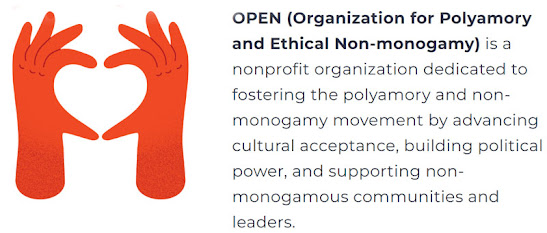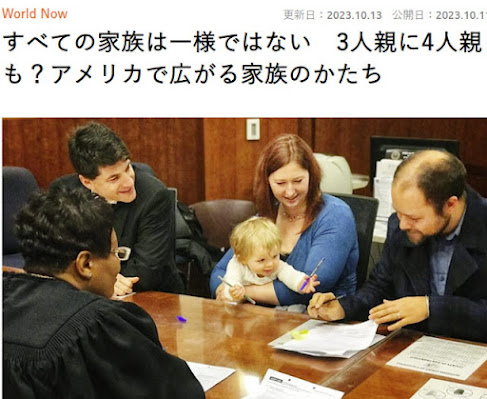The best history yet of the polyamory movement's origins. Choosing if poly is right for you. And more.
Polyamory seems to have burst upon the American mainstream over the past two decades. The deluge of podcasts, TV shows, books, and magazine articles detailing polycules, metamores, throuples, threesomes, and moresomes testifies to the growing number of Americans willing to jettison monogamy....Though studies have shown that Americans from across the political spectrum have embraced forms of consensual non-monogamy, it tends to be liberal progressives who publicly laud polyamory as the next stage of the sexual revolution, while religious conservatives bemoan it as the next step in more than half a century of moral decline. Yet, setting polyamory within the longer history of American sexual dissent uncovers a complicated relationship between politics and sexual freedom that defies simplistic categorization.

Christopher M. Gleason ...Polyamory’s roots [in America] reach back at least a century to the Progressive Era, if not further, when Bohemian notions of free love breached major U.S. metropolises. The “Roaring Twenties” that ensued prefigured the sexual revolution of a half century later, as wars over birth control and the Equal Rights Amendment divided Americans....The post-Depression era stifled sexual freedom. By the 1940s, the twin threats of nuclear annihilation and the spread of godless Communism exacerbated the return to sexual traditionalism, producing a cultural consensus on marriage and family that tolerated little dissent....[From the late 1940s through the 50s] the Beats were not the only Americans to chide mainstream mores, nor to use literature to do so. There was also Ayn Rand, the anti-statist Russian-born novelist bent on destroying all impediments to personal autonomy. Rand dabbled with ethical non-monogamy, believing that her and her protege's shared commitment to her philosophy of Objectivism provided sanction for their intimacy. Though they were honest about the relationship, it brought great emotional distress to both their spouses, and her disregard for the feelings of all others involved made it unlikely for polyamorists to claim her as an intellectual forebear.The clearest link between polyamory and the first decades of the 20th century is traceable through the influence of acclaimed science fiction writer Robert Heinlein. Referring to himself as a “child of the Torrid Twenties,” Heinlein was a sexual iconoclast. His first two marriages in 1929 and 1932 were both open, and he spent the 1930s and 1940s frequenting nudist clubs, and running in countercultural circles that included the occultic sex magician and Cal Tech rocket scientist Jack Parsons.......Heinlein’s rightward turn [post-war] did little to temper his promotion of sexually transgressive ideas. If anything, it reinforced the notion that sexual freedom should be protected as a private right. He lamented monogamy and monotheism as the two sacred cows of western civilization and continued to take aim at both in his novels. The [first] of such efforts was his 1961 novel Stranger in a Strange Land. The novel, which follows a human raised on Mars who returns to Earth and starts a church that rejects jealousy in lieu of ritualistic free love, took little time to become canonical within 1960s counterculture....The decisively conservative shift of the 1980s did much to halt the sexual revolution. Yet, it was within this conservative climate that disparate poly factions united. This [new,] predominately female-led coalition began publicly organizing, printing newsletters, planning conferences, and making media appearances.In doing so, they rejected outdated versions of 1960s free love as wanton hedonism. In its place, they learned to speak the language of Reagan, arguing that when rooted in commitment, ethical non-monogamy was not antithetical to family values. In fact, it centered the family, providing greater emotional and financial stability in an age increasingly marred by political and economic uncertainty. Or as Ryam Nearing, the co-founder of the influential polyamory non-profit Loving More argued in 1984, committed multi-partner relationships were identical to monogamous relationships in that they were characterized by the joys and trials of navigating careers, childrearing, spirituality, and asset sharing. What they offered that monogamy could not was “far greater economic security, and an increase in loving parents and role models.” For Nearing, ethical non-monogamy meant “intimacy without nuclear couple isolation, multiplicity without shallowness.” Furthermore, those truly committed to the freedom afforded by limited government had no basis to deny such unions.Many polyamorists no longer focus narrowly on commitment. Though their relationships may be lifelong, they tend to rest their sexual ethics on ideals of honesty, open communication, and mutual respect. For many of these Americans, polyamory remains a private matter. Others believe polyamory is a civil rights issue. Echoing their forebears, they claim that polyamory is not an assault on the American family, but rather a timely defense of it.Christopher M. Gleason is the Academic Director for the Georgia Coalition for Higher Education in Prison, part-time Assistant Professor at Kennesaw State University, and author of American Poly: A History.

|
| Glen Olson and Terry Brussel-Rogers |
was the culmination of three dominant trends happening in America at the time. The civil rights movement had been changing people's hearts throughout the 1960s, making activism respectable. The Human Potential Movement [had been] quietly gaining momentum all decade with the message that you can change who you are for the better. ... And the literary Beat culture of the 1950, whose basic tenets included challenging your preconceptions, making a spiritual quest, and rejecting economic materialism, had turned into the popular and energetic hippie movement of the 1960s. ... The fervor of these secular movements infused the following decade with excitement about human potential and the ability to love.
By Marianna Zelichenko

Choosing a path. The author's
caption: "Thank you, Dall-E"
In my last post, I shared how our polycule has fallen apart after James and Annie broke up. Thomas left a comment saying:“The only thing that surprises me about the polyamorous community is how surprised they continue to be that their relationship model doesn’t work any better than the monogamy model.”...So let’s discuss: Does the polyamorous model work better?...When the polyamorous model works better:
• ...You have needs that are important to you and can’t be met in just one romantic relationship (for instance because you have conflicting needs)• AND/OR you have a strong craving for freedom when it comes to relationships• OR you don’t feel the need to date multiple people, but you don’t mind it when your partner does.• AND you’re willing and capable to put in the work that is required to manage multiple relationships simultaneously, including dealing with jealousy and alone time, managing time, resources, and expectations, and communicating clearly and constructively.If this is true for you, the polyamorous model likely works better, because it’s a better fit for your needs.(Disclaimer: I’m not taking into account practical matters, such as the access to other polyam folks in your community, etc. — this is a separate matter entirely.)When the monogamous model works better:• ...You can have your important romantic needs met with just one partner.• AND You don’t mind or are even happy being with one romantic partner.• AND/OR The benefits of being exclusive with one partner matter to you (such benefits may include relative predictability/stability in your schedule, or acceptance from the outside world)• AND you are willing and capable to put in the work that is required to find your way back to each other as both of you grow as human beings, so that you keep meeting each other’s romantic needs and don’t grow apart.---------------What if it’s neither?You may have noticed that with both models, I’m focusing on the pull — the things that are appealing about each of them. But both models also come with their own challenges....If you’re not willing to communicate with your partner about your needs, you might choose monogamy, but I question whether your relationship will still be happy and fulfilling down the line.If you don’t want to take into account your partner’s needs, dating multiple people might bring you a short reprieve first, but is likely to bring you a whole lot of headache after.In the end, relationships are human, and humans are messy. Polyamory doesn’t cure us from that (and neither does monogamy). But for a lot of us, I do believe polyamory is a ‘better’ model, leading to a life of more freedom and fun.Last summer, we launched a deck of Polyamory Conversation Cards that help tackle the many different aspects of polyamorous relationships. In 49 prompts, you’ll explore topics such as emotional security, sexuality, and practical matters. Grab your deck in the webshop.
By Sophie Saint Thomas
Polyamory...In this often-attempted relationship format, which genuinely does feel like coming home and works wonders for many proud poly people, you form romantic and sexual relationships with more than one partner. Many are called. Few can serve.Hierarchical PolyHierarchical polyamory usually involves a couple. They're each other's number one, emergency contact, and "primary partner," but they can see other people (secondary partners). And those second partners better know their place. Kidding! But really.......Relationship AnarchyScrew your rules and reliance on romance. Relationship anarchists consider all their partnerships equally valid whether they bone or not. ... They're all equal, and they're so much more punk than the pumpkin spice latte sipping poly crowd. ...
● From CNN Portugal: The Teatro Villare in Lisbon premieres “Baby, I want to kiss more people” (Nov. 4) "Diogo Varo and Joana Brito Silva made a show to talk about their non-monogamous relationship." Says Varo,
People quickly assume that non-monogamy is about how many people you live with, but it’s actually a political way of living life. ... Non-monogamy is about being honest – first with ourselves. ... But it’s also about being honest with others, whether they’re like you’re the main partner or not. You need to respect others and know how to communicate with partners.

|
|
One couple, many hands. "A new mural
painting in Kyiv dedicated to Ukrainian volunteers. If you have helped Ukrainians during this year and a half, you may consider yourself to be one of them." |
Here was a country with a tragic history that had at last begun to build, with great effort, a better society. What made Ukraine different from any other country I had ever seen—certainly from my own—was its spirit of constant self-improvement, which included frank self-criticism. For example, there’s no cult of Volodymyr Zelensky in Ukraine—a number of Ukrainians told me that he had made mistakes, that they’d vote against him after the war was won. Maxim Prykupenko, a hospital director in Lviv, called Ukraine “a free country aspiring to be better all the time.” The Russians, he added, “are destroying a beautiful country for no logical reason to do it. Maybe they are destroying us just because we have a better life.”

|
|
Ukraine's LGBT military unicorn. The thorns and barbed wire represent old restrictions now being cut away. |

|
|
Women fighters in a trench in the Donetsk
region |
Labels: #LovingMore, #PolyamoryHistory, #PolyHistory, history, history of polyamory, Loving More, polyamory history









 As always, thank you for being part of the movement for a more open and inclusive world!
As always, thank you for being part of the movement for a more open and inclusive world!




